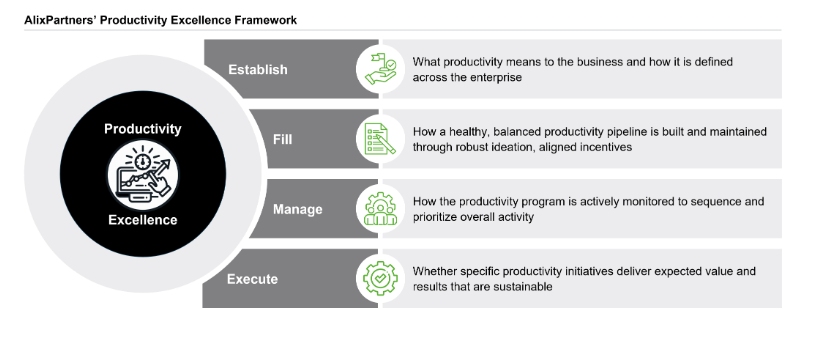How can consumer products companies consistently exceed productivity targets in a world of constant disruption? This was the central question at the 2025 Consumer Products Executive Productivity Forum, hosted by AlixPartners. The forum brought together industry leaders to share strategies, challenges, and best practices for driving productivity—an imperative that sits at the core of value creation, margin defense, and innovation funding.
With inflation, tariffs, and geopolitical risks reshaping the landscape, the conversation focused on how top-performing organizations achieve 3–5% annual productivity gains, and why the new benchmark is rapidly shifting to 5% and beyond. See below for a summary of our discussion and the AlixPartners' Productivity Excellence Framework.

- Set the right aspiration. Productivity needs to link to a multi-year total shareholder return target for the company, and in an era of low to no growth (in volume and price), productivity aspirations often need to be much bigger than planned.
- Install the right hardware and software. There is no one right answer, but key elements need to be in place: common definitions, single source of truth, active PMO governance, multi-horizon target-setting, pipeline review, and execution management.
- Fill the funnel. Need to take a multi-faceted approach, enlisting the frontline, leveraging "building blocks" to focus and prioritize resources, seeking major technical, process, or VSM unlocks, and ensuring access to the external "ideas market" at scale.
- Make it "real." Financial measures provide the ultimate outcome (EBIT improvement), but driving sustained productivity means seeing on-the-ground improvements in physical measures such as $ per unit produced or plant OEE.
- Don't let it slip. It's not enough to ensure that productivity reaches the bottom line. It must be sustained. Don't just count the wins and forget the losses or set up and knock over the same pins year to year.
The path to productivity excellence is neither linear nor easy, but it is achievable. As highlighted in the forum, success depends on building high-functioning productivity engines, integrating commercial and operational functions, and maintaining a robust multi-year pipeline of initiatives. Companies must balance top-down objectives with cross-functional collaboration, leverage new technologies like AI/ML, and rigorously monitor both financial and physical metrics to ensure true impact.
Ultimately, productivity excellence is a cycle of purposeful execution, consistent accountability, and continuous improvement. The question for every organization: Are you aiming high enough, and is your model truly delivering sustainable results?
The content of this article is intended to provide a general guide to the subject matter. Specialist advice should be sought about your specific circumstances.





